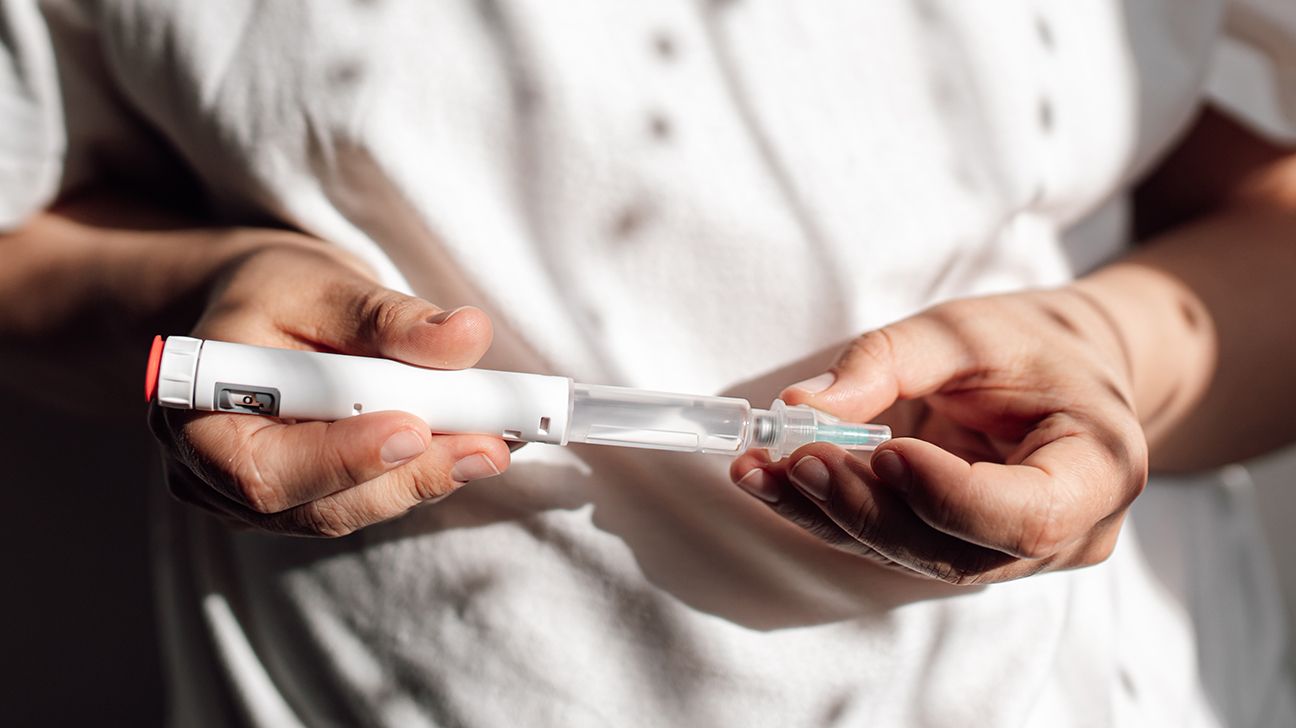Injection site reactions are the most common side effect of Emgality. The most frequent injection site reaction is pain. But there are steps you can take to help prevent or reduce pain from Emgality injections.
Emgality (galcanezumab-gnlm) is a prescription drug used to help prevent migraine and treat episodic cluster headaches. Emgality comes as a liquid solution in prefilled pens and syringes. You use the pen or syringe to inject the drug into the fatty tissue just under your skin. This is called a subcutaneous injection.
Read on to learn about how to inject Emgality, potential injection site reactions, and steps you can take to help reduce pain.

Side effects of Emgality consist mostly of injection site reactions and (in rare cases) an immune system response called a hypersensitivity reaction.
Emgality injection site reactions
According to the drug’s studies, injection site reactions are the most common side effect of Emgality. These are reactions that happen around the area where you inject the drug.
A
- pain
- redness or discoloration
- itching
Injection site pain was the most frequent reaction reported overall and the most commonly reported within 60 minutes of the injection. About half the people who had injection site pain said it felt like a burning sensation.
Other types of site reactions that can potentially occur after a subcutaneous injection include:
- swelling
- bruising or bleeding
- skin discoloration
- skin hardening, called induration
Why does an Emgality injection hurt?
Many factors can affect how much pain an injection, like Emgality, can cause. Because Emgality comes in a prefilled syringe or pen, some of the factors affecting pain are out of your control. These include:
- the needle gauge (thickness)
- the amount of drug you inject (dose)
- qualities of the liquid in the syringe, such as:
- its pH level
- how viscous (thick) it is
- whether it contains preservatives or lubricants
Factors affecting pain that you have some control over include:
- the injection site
- the temperature of the syringe or pen
- the speed of the injection
- your injection technique
- the injection device (syringe versus pen)
The
Does Emgality cause other side effects?
An immune system response called a hypersensitivity reaction is another potential side effect of Emgality. Symptoms include rash, hives, and shortness of breath. According to the drug’s studies, these reactions can occur days after injection.
You’re advised to seek immediate medical care if you develop hypersensitivity reaction symptoms after an Emgality injection.
Does Emgality cause hair loss?
Hair loss (alopecia) was not reported as a side effect of Emgality. (A participant in one
Does Emgality cause depression?
Depression wasn’t a side effect reported in Emgality studies. But depression is more common in people who experience
If you think you’re experiencing depression or another mental health condition, it’s important to talk with your doctor.
Does stopping Emgality cause withdrawal symptoms?
It’s unlikely. (Withdrawal symptoms are side effects caused by suddenly stopping or lowering your dose of a drug.)
However, if you’re using Emgality to prevent migraine, your migraine episodes may return or become more frequent after you stop treatment.
It’s important that you do not stop Emgality treatment without first talking with your doctor.
Emgality comes in a prefilled pen or syringe for preventing migraine and a prefilled syringe for treating cluster headaches. The way you inject the drug depends on whether it’s in a syringe or a pen.
When a healthcare professional first prescribes Emgality, they’ll show you how to prepare and inject the drug.
Where is the best place to inject Emgality?
There’s no “best place” to inject Emgality. An area that may not be that painful for one person could be very painful for another.
You can inject Emgality in the following locations:
- abdomen, at least 2 inches from your belly button
- front of your thigh, at least 2 inches above your knee, and at least 2 inches below your groin
- back of the upper arm or the buttock, with the help of another person
A
How much does the Emgality shot hurt?
The Emgality shot may hurt, but pain intensity differs from person to person. A
How do I stop Emgality from hurting?
There are several steps you can take to help prevent pain related to your Emgality injection.
Manage your injection sites
Try different injection locations until you find the one that’s least painful for you. Check that the site isn’t tender, discolored, or bruised. It’s advisable to rotate injection sites, as using the same site each time can increase irritation. For example, if you previously injected Emgality in the left side of your abdomen, inject your next dose on the right side.
Take the chill out
Injecting Emgality while the liquid is cold can be painful. Allow your Emgality syringe or pen to reach room temperature before using it. This may take up to 30 minutes.
Numb your skin
Apply an ice pack to the area where you intend to inject Emgality to help numb your skin beforehand. Your doctor may also be able to suggest or prescribe a numbing cream.
Relax
Tensing up may make your injection more, so try to relax before injecting your dose. Tips for this include:
- injecting at a time when you don’t feel rushed
- choosing a calm, comfortable environment
- distracting yourself, such as by talking with another person or listening to soothing music
Use the appropriate injection technique
Inject Emgality at the correct angle, which is 45 degrees for prefilled syringes and 90 degrees for prefilled pens.
Ask about switching injection methods
Ask your doctor whether you can use a prefilled pen instead of a prefilled syringe. According to a
If you have injection site pain with Emgality, you can help reduce it by:
- applying a warm or cool compress to the injection site
- taking an over-the-counter (OTC) pain medication such as acetaminophen (Tylenol) or ibuprofen (Advil, Motrin)
Most Emgality injection site reactions go away
Talk with your doctor if you have severe, ongoing, or worsening pain after your Emgality injections. They can help you develop a method to make the injections less painful. Or they may suggest switching to a different migraine or cluster headache treatment.
Injection site reactions, including pain, are the most common side effect of Emgality. These reactions are typically mild to moderate in intensity and go away on their own a day or two after the injection.
OTC pain relief and warm or cool compresses may help. However, it’s best to talk with a doctor if you have injection site pain that worsens, is ongoing, or is severe.
Disclaimer: Healthline has made every effort to make certain that all information is factually correct, comprehensive, and up to date. However, this article should not be used as a substitute for the knowledge and expertise of a licensed healthcare professional. You should always consult your doctor or another healthcare professional before taking any medication. The drug information contained herein is subject to change and is not intended to cover all possible uses, directions, precautions, warnings, drug interactions, allergic reactions, or adverse effects. The absence of warnings or other information for a given drug does not indicate that the drug or drug combination is safe, effective, or appropriate for all patients or all specific uses.









